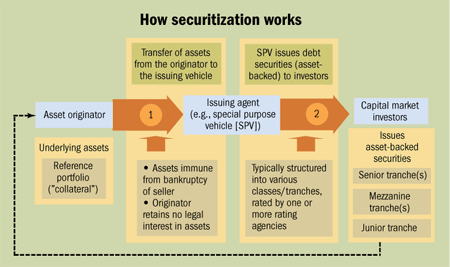Securitization is the process of taking an illiquid asset, or group
of assets, and through financial engineering, transforming them into a security
Asset Backed security- A bond
offering that has no such certainty. Government or private company does not back
the security in most cases but rather a creditor most often a lender issues
securities supported by stream of income. There is no guarantee that the income
will be received as anticipated, sometimes the asset will be liquidated then
expected which results in less interest income then the bondholders assumed
they would receive. Hence the future cash flow can only be guessed. Accepting this uncertainty, investors are
able to achieve higher returns then on a regular government or corporate bond.
Asset backed securities are sold either fixed rates of interest or
floating rates.
Divided into two categories.
Mortgage backed securities- supported by first mortgages on
residential properties.
Non-Mortgage securities- These can be backed by assets of any other
sort, including house related loans other then first mortgages.
The entity that originally holds the assets (the originator)
initiates the process by selling the assets to a legal entity, an SPV (Special
Purpose Vehicle), specially created to limit the risk of the final investor the
issuer of the assets. An SPV is also referred to as a “conduit.” Depending on the situation, the SPV either
issues the securities directly or resells the pool of assets to a “trust” that,
in turn, issues the securities (the trust is actually used for several
securitization transactions and therefore oversees several SPVs).
An SPV is more of a legal framework than an element that plays an
active part in the transaction. The most important role is played by the
arranger, typically a bank, who sets up the transaction and evaluates the pool
of assets, the way in which it will be fed, the characteristics of the
securities to be issued, and the potential structuring of the fund.
The object of the structuring is to model the characteristics of the
securities such that they correspond to the needs of the final investor.
Instead of simply paying the final investor the revenue generated by the
assets, the amortization rules for the security are defined in advance.
Some ABSs can be “topped up,” meaning that the pool of assets can be
referred during the life of the security. This allows it to refinance
short-term debts with long-term bonds.
Finally, the arranger plays an important role in distributing the
securities to the final investors (distribution). Quite often, the securities
are not issued on an exchange, but are distributed over-the-counter to a small
number of investors.
The trio of actors comprising the “originator, SPV, and arranger”
constitutes the “Originate-to-Distribute” model, which has thrived over the
course of the past few years.
An important distinction must be made between “traditional”
securitization, where the assets are actually sold to the SPV (“true sale”),
and what is known as “synthetic” securitization, where the originator retains
ownership of the assets and transfers only the risk to the SPV, via a credit
derivative. This transaction brings no liquidity to the assignor, but enables to
externalize the risk associated with holding the securitized assets.
Advantages
of Securitization
The
Seller Main reason for securitizing is to reduce the
amount of assigned debt from his balance sheet, which on the one hand leads to
a corresponding reduction in his regulatory capital requirements under Basel
II, and on the other hand enables him to bring in additional liquidity (which
can be used to make new loans).
The
investor
ABS presents an opportunity to invest in asset classes that are not
accessible in the markets and that offer a risk/return profile that is, in
principle, attractive. “ABS are a means of diversifying a portfolio into
low-risk products that, by virtue of their structure, offer exposure to a
diversified portfolio.”
“Since the underlying assets are
diversified, clearly identified, and pledged to the holder, the credit rating
agencies claim that in the event of default (theoretically speaking), the
recovery rate for the holder is very high.”
The
Market Securitization helps to spread out risk
within the market, so that the risk is no longer concentrated solely in the
hands of credit agencies.
Drawbacks
of securitization
Information
Asymmetry
Issuer of the securities knows much more about what he is really selling
than the buyer (investor) does. Akerlof first described this mechanism in terms
of the used-car market (“The market for Lemons”).
People become suspicious of any product
falling within that category – since you really need to be an expert to be able
to evaluate a securitization program –and suddenly nobody wants to buy them
anymore.
Moral
hazard The
banks have moved away from their role of financing the economy, seeking instead
to assume (fortunately, not completely) a purely intermediary role in an
economy that seems to have become completely “marketized.” Today, the situation
is reaching its limits.

No comments:
Post a Comment